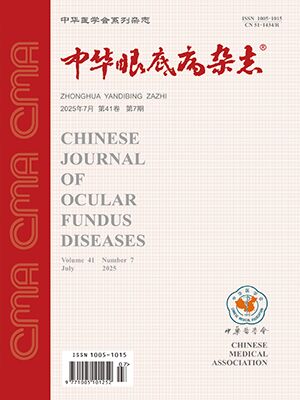| 1. |
惠延年. 年龄相关性黄斑变性的新概念: 定义与发病机制[J]. 中华眼底病杂志, 2024, 40(3): 171-174. DOI: 10.3760/cma.j.cn511434-20240110-00019.Hui YN. New concepts of age-related macular degeneration: definition and pathogenesis[J]. Chin J Ocul Fundus Dis, 2024, 40(3): 171-174. DOI: 10.3760/cma.j.cn511434-20240110-00019.
|
| 2. |
Sakurada Y, Tanaka K, Fragiotta S. Differentiating drusen and drusenoid deposits subtypes on multimodal imaging and risk of advanced age-related macular degeneration[J]. Jpn J Ophthalmol, 2023, 67(1): 1-13. DOI: 10.1007/s10384-022-00943-y.
|
| 3. |
Arnold JJ, Sarks SH, Killingsworth MC, et al. Reticular pseudodrusen. A risk factor in age-related maculopathy[J]. Retina, 1995, 15(3): 183-191.
|
| 4. |
Rudolf M, Malek G, Messinger JD, et al. Sub-retinal drusenoid deposits in human retina: organization and composition[J]. Exp Eye Res, 2008, 87(5): 402-408. DOI: 10.1016/j.exer.2008.07.010.
|
| 5. |
Rabiolo A, Sacconi R, Cicinelli MV, et al. Spotlight on reticular pseudodrusen[J]. Clin Ophthalmol, 2017, 11: 1707-1718. DOI: 10.2147/OPTH.S130165.
|
| 6. |
Zarubina AV, Neely DC, Clark ME, et al. Prevalence of subretinal drusenoid deposits in older persons with and without age-related macular degeneration, by multimodal imaging[J]. Ophthalmology, 2016, 123(5): 1090-1100. DOI: 10.1016/j.ophtha.2015.12.034.
|
| 7. |
Wightman AJ, Guymer RH. Reticular pseudodrusen: current understanding[J]. Clin Exp Optom, 2019, 102(5): 455-462. DOI: 10.1111/cxo.12842.
|
| 8. |
中华医学会眼科学分会眼底病学组, 中国医师协会眼科医师分会眼底病学组. 中国年龄相关性黄斑变性临床诊疗指南(2023年)[J]. 中华眼科杂志, 2023, 59(5): 347-366. DOI: 10.3760/cma.j.cn112142-20221222-00649.Fundus Pathology Group, Ophthalmology Branch, Chinese Medical Association, Ophthalmology Branch, Chinese Medical Doctor Association. Evidence-based guidelines for diagnosis and treatment of age-related macular degeneration in China (2023)[J]. Chin J Ophthalmol, 59(5): 347-366. DOI: 10.3760/cma.j.cn112142-20221222-00649.
|
| 9. |
Ueda-Arakawa N, Ooto S, Tsujikawa A, et al. Sensitivity and specificity of detecting reticular pseudodrusen in multimodal imaging in Japanese patients[J]. Retina, 2013, 33(3): 490-497. DOI: 10.1097/IAE.0b013e318276e0ae.
|
| 10. |
Age-Related Eye Disease Study Research Group. A randomized, placebo-controlled, clinical trial of high-dose supplementation with vitamins C and E, beta carotene, and zinc for age-related macular degeneration and vision loss: AREDS report no. 8[J]. Arch Ophthalmol, 2001, 119(10): 1417-1436. DOI: 10.1001/archopht.119.10.1417.
|
| 11. |
Suzuki M, Sato T, Spaide RF. Pseudodrusen subtypes as delineated by multimodal imaging of the fundus[J]. Am J Ophthalmol, 2014, 157(5): 1005-1012. DOI: 10.1016/j.ajo.2014.01.025.
|
| 12. |
Çeper SB, Afrashi F, Değirmenci C, et al. Multimodal imaging of reticular pseudodrusen in turkish patients[J]. Turk J Ophthalmol, 2023, 53(5): 275-280. DOI: 10.4274/tjo.galenos.2023.85616.
|
| 13. |
Agrón E, Domalpally A, Cukras CA, et al. Reticular pseudodrusen status, ARMS2/HTRA1 genotype, and geographic atrophy enlargement: age-related eye disease study 2 report 32[J]. Ophthalmology, 2023, 130(5): 488-500. DOI: 10.1016/j.ophtha.2022.11.026.
|
| 14. |
Holz FG, Saßmannshausen M. Reticular pseudodrusen: detecting a common high-risk feature in age-related macular degeneration[J]. Ophthalmol Retina, 2021, 5(8): 719-720. DOI: 10.1016/j.oret.2021.05.005.
|
| 15. |
Smith RT, Sohrab MA, Busuioc M, et al. Reticular macular disease[J]. Am J Ophthalmol, 2009, 148(5): 733-743. DOI: 10.1016/j.ajo.2009.06.028.
|
| 16. |
Weber S, Simon R, Schwanengel LS, et al. Fluorescence lifetime and spectral characteristics of subretinal drusenoid deposits and their predictive value for progression of age-related macular degeneration[J]. Invest Ophthalmol Vis Sci, 2022, 63(13): 23. DOI: 10.1167/iovs.63.13.23.
|
| 17. |
Wu Z, Zhou X, Chu Z, et al. Impact of reticular pseudodrusen on choriocapillaris flow deficits and choroidal structure on optical coherence tomography angiography[J]. Invest Ophthalmol Vis Sci, 2022, 63(12): 1. DOI: 10.1167/iovs.63.12.1.
|
| 18. |
Mimoun G, Soubrane G, Coscas G. Significance of the digitalimage in the diagnosis and classification of macular drusen[J]. Ophtalmologie, 1990, 4(1): 48-50.
|
| 19. |
Zweifel SA, Spaide RF, Curcio CA, et al. Reticular pseudodrusen are subretinal drusenoid deposits[J]. Ophthalmology, 2010, 117(2): 303-312. DOI: 10.1016/j.ophtha.2009.07.014.
|
| 20. |
Querques G, Querques L, Forte R, et al. Choroidal changes associated with reticular pseudodrusen[J]. Invest Ophthalmol Vis Sci, 2012, 53(3): 1258-1263. DOI: 10.1167/iovs.11-8907.
|
| 21. |
Zhang Y, Wang X, Sadda SR, et al. Lifecycles of individual subretinal drusenoid deposits and evolution of outer retinal atrophy in age-related macular degeneration[J]. Ophthalmol Retina, 2020, 4(3): 274-283. DOI: 10.1016/j.oret.2019.10.012.
|
| 22. |
Trinh M, Eshow N, Alonso-Caneiro D, et al. Reticular pseudodrusen are associated with more advanced para-central photoreceptor degeneration in intermediate age-related macular degeneration[J]. Invest Ophthalmol Vis Sci, 2022, 63(11): 12. DOI: 10.1167/iovs.63.11.12.
|
| 23. |
Xu X, Liu X, Wang X, et al. Retinal pigment epithelium degeneration associated with subretinal drusenoid deposits in age-related macular degeneration[J]. Am J Ophthalmol, 2017, 175: 87-98. DOI: 10.1016/j.ajo.2016.11.021.
|
| 24. |
Dutheil C, Le Goff M, Cougnard-Grégoire A, et al. Incidence and risk factors of reticular pseudodrusen using multimodal imaging[J]. JAMA Ophthalmol, 2020, 138(5): 467-477. DOI: 10.1001/jamaophthalmol.2020.0266.
|
| 25. |
Wilde C, Patel M, Lakshmanan A, et al. Prevalence of reticular pseudodrusen in eyes with newly presenting neovascular age-related macular degeneration[J]. Eur J Ophthalmol, 2016, 26(2): 128-134. DOI: 10.5301/ejo.5000661.
|
| 26. |
Spaide RF, Ooto S, Curcio CA. Subretinal drusenoid deposits AKA pseudodrusen[J]. Surv Ophthalmol, 2018, 63(6): 782-815. DOI: 10.1016/j.survophthal.2018.05.005.
|
| 27. |
Monge M, Araya A, Wu L. Subretinal drusenoid deposits: an update[J]. Taiwan J Ophthalmol, 2022, 12(2): 138-146. DOI: 10.4103/tjo.tjo_18_22.
|
| 28. |
Querques G, Canouï-Poitrine F, Coscas F, et al. Analysis of progression of reticular pseudodrusen by spectral domain-optical coherence tomography[J]. Invest Ophthalmol Vis Sci, 2012, 53(3): 1264-1270. DOI: 10.1167/iovs.11-9063.
|
| 29. |
Parravano M, Querques L, Boninfante A, et al. Reticular pseudodrusen characterization by retromode imaging[J/OL]. Acta Ophthalmol, 2017, 95(3): e246-e248[2016-01-27]. https://pubmed.ncbi.nlm.nih.gov/26815408/. DOI: 10.1111/aos.12948.
|
| 30. |
Chen L, Messinger JD, Zhang Y, et al. Subretinal drusenoid deposit in age- related macular degeneration: histologic insights into initiation, progression to atrophy, and imaging[J]. Retina, 2020, 40(4): 618-631. DOI: 10.1097/IAE.0000000000002657.
|
| 31. |
Wu Z, Fletcher EL, Kumar H, et al. Reticular pseudodrusen: a critical phenotype in age-related macular degeneration[J/OL]. Prog Retin Eye Res, 2022, 88: 101017[2021-11-06]. https://pubmed.ncbi.nlm.nih.gov/34752916/. DOI: 10.1016/j.preteyeres.2021.101017.
|




